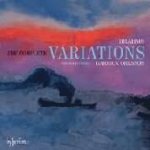These strong, stylish, intelligently mapped-out, and excellently engineered interpretations of Brahms’ complete solo-piano variation sets find pianist Garrick Ohlsson on peak technical and musical form. The impetuous fervor and tempo extremes that characterized his 1977 EMI release of the Handel and Paganini variation sets (once available on Angel LP S-37249, and never reissued on CD in the West, to the best of my knowledge) have given way to steadier, better integrated tempos and an altogether stronger linear awareness that yields greater textural diversity and color without sacrificing power and mass. What is more, ear-catching rubatos, voicings, and articulations are borne out of what’s in the score.
For example, the pianist’s measured tempo for Paganini Book II’s third variation makes for clearer contrast between the right hand’s alternating slurred double notes and staccato octaves, along with an uncommonly humorous emphasis on the left-hand repeated notes and accents. Similarly, while Variation Eight moves much slower than Brahms’ Allegro marking indicates, the tempo allows the composer’s quasi-pizzicato indication to register all the more effectively. Here, incidentally, Ohlsson observes Brahms’ ossia text on the repeats. Also, in Book I, notice Variation Four’s steady vehemence and absolutely uniform trills, the sonorous, full-bodied projection of the contrary motion phrases in Variations Seven and Eight, and the exceptionally clean, absolutely effortless glissando octaves in Variation Thirteen.
Ohlsson’s Handel Variations operate at a high level of distinction. He points up Variation One’s left-hand staccatos in appropriately woodwind-like fashion, and he’s one of the few pianists to correctly align No. 3’s rhythmic displacements. The remaining variations also abound with insightful details and felicitous dabs of color, leading toward the final variations’ steady, cumulative build and flexibly delineated final fugue.
Acute attention to detail often yields revelatory results in the other variation sets. Cases in point: how the Op. 9 second variation’s espressivo right-hand syncopated chords and the staccato left-hand single line emerge eerily and effectively independent of each other; the unusually stern and headlong treatment of Op. 21 No. 1’s main theme; Ohlsson’s virile, dead-of-center execution of octaves, broken and unbroken, in Op. 21 No. 2 and in the D minor variations transcribed from the Op. 18 Sextet’s second movement.
It goes without saying that there are many valid ways to play these works, and that Ohlsson’s Brahms won’t necessarily displace one’s affection for, say, Katchen’s more freewheeling approach, or the lighter panache that Jean-Yves Thibaudet and Evgeny Kissin bring to the Paganini Variations. Yet Ohlsson realizes his conceptions to the fullest extent, and as such has given us one of the finest recordings of his long career. [11/22/2010]
































